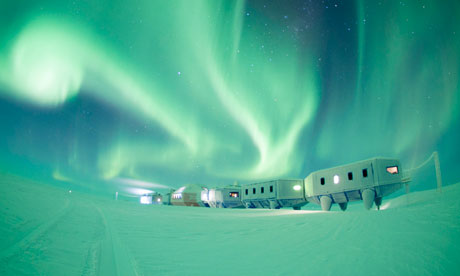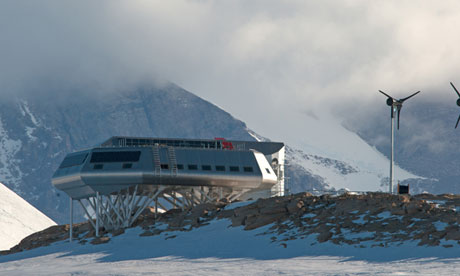What It's Like To Spend A Year In The
Beautiful Wastes Of Antarctica
Antarctica is an isolated, frigid desert of ice and snow. It’s practically another planet. And it can bestaggeringly beautiful. Ian Hey did something most of us would never dream of and spent a year there. This is what it was like.
The footage, stills, and timelapses cover a variety of events in and around the Halley VI lab, from getting supplies to taking care of maintenance to just hanging out. It’s all fantastic. Kinda makes you want to visit right? MOVIE
This is the first part of our Journey south to Halley research Station.
Witness the cold difficulty in getting to Research stations in Antarctica.
It takes wee longer than expected!
Witness the cold difficulty in getting to Research stations in Antarctica.
It takes wee longer than expected!
Antarctic research stations: exposed to the elements and now to the public
New exhibition brings together research stations that have survived in one of the most inhospitable places on the planet
The Belgian base, Princess Elisabeth, is the first zero-carbon station, powered by wind and solar energy and built from super-insulated wooden cassettes. Photograph: International Polar Foundation
A primary colored caterpillar on skis, a silvery pod on stilts and an electric blue starfish: they could be prototype vehicles for the next installment of the Star Trek franchise, but these are all architectural responses to making shelter in the coldest, windiest and driest place on Earth.
Curated by the British Council with the Arts Catalyst, Ice Lab brings together a series of research stations from the last decade of our forays into Antarctica – extreme buildings for one of the most inhospitable places on the planet.
The exhibition, on show at the Lighthouse gallery in Glasgow before travelling to Manchester in October, comes after the recent completion ofHalley VI, the latest iteration of Britain's home on the Brunt Ice Shelf, where temperatures drop to -50C, winds rage at 100mph, and the next nearest humans are 700 miles away.
With snow levels rising by over a metre annually, it is a climate that has caused previous stations to be buried every 10 years. Photos show the rusty frame of Halley III emerging from a thick white cliff-face, like chocolate shards in a slice of Viennetta.
To avoid the same fate, Halley VI can move. Jacked up on ski-legs, its bulbous pods can be dragged over the ice, recalling the Walking City of 1960s dreamers Archigram. It has the same pop sensibility, with capsules wrapped in union flag colours like a little piece of Britain laid out across the endless white sheet.

National customs also continue within. Menus from the scientists' midwinter feasts in the 1950s feature toasts to the Queen, in between courses of penguin's eggs – a dish that has since been strictly outlawed.
While Halley's pods extend like the carriages of a train or a street of terraced houses, it is interesting to see how other countries have opted for structures that reflect their own national characters. The American McMurdo base rambles in a complex of big box industrial sheds, like a chunk of suburban sprawl. It is thought to have the biggest carbon footprint of any building in the world. The Belgian base, Princess Elisabeth, is the first zero-emission station, powered by wind and solar energy and built from super-insulated wooden cassettes. Photos show its crew assembled around a long banqueting table, with exposed timber beams giving the feeling of a cosy beer hall.
The Indian Bharathi station shares similar eco-credentials, constructed from the very shipping containers that carried the building equipment to the site. Fitted with long panoramic windows, its interior has the look of a first-class airport lounge from the 1970s, with reclining executive chairs and cream leather sofas. It is a far cry from the slick computer renderings of South Korea's ambitious Jang Bogo complex, due to open next year as one of the biggest stations yet. A stealthy three-pronged star, encrusted with a blue sequin skin of solar cells, its aerodynamic body hovers above the ice on delicate legs. It is the encapsulation of Korea's fast-paced technology-driven national identity.
Compared with the primitive cabins of the first Antarctic explorers, these are buildings as high-performance machines, the architectural equivalent of zip-up Gore-Tex to Shackleton's tweed. As architect Sam Jacob writes in an accompanying essay, they show a "hyper-accelerated history of architecture itself, progressing from the hut to the space station in just over a hundred years".
It is an architectural leap that mimics a scientific leap: researchers now spend their time launching balloons to search for primordial antimatter and hunting for ghost particles with a telescope buried 2.4km into the ice.
There are hints of a possible next chapter to come. David Garcia, of speculative studio Map architects, exhibits a plan for a subterranean station imagined as a spidery network of wormholes and caves, burrowed into the ice using caterpillar diggers.
Inspired by the way igloos use compacted snow for insulation it would, he says, entirely remove the need to transport foreign materials to Antarctica. Nor would it require dismantling or removal, melting in seven to 10 years and leaving no trace. The future of Antarctic architecture may be entirely invisible.
Ice Lab New Architecture and Science in Antarctica is at Architecture and Design Scotland at the Lighthouse 26 July to 2 October 2013
• This article was amended on 29 July 2013. The Belgian Princess Elisabeth station is zero-emission, not zero-carbon as previously stated. The article also stated that the American McMurdo base is at the South Pole, but is in fact on Ross Island, at 77 degrees south.
ADD YOUR NAME TO THE SWELL
Share this
video and visit our website to take action: JOIN US! SIGN HERE!
YOU'LL NEVER BELIEVE HOW MANY RESEARCH STATIONS!
Go to Wikipedia to read about ALL the Antarctic Research Stations - It is pretty astounding!
 |
| Argentine Base 2013 Marilyn Morningstar |



No comments:
Post a Comment
Thanks for your post. All posts are moderated prior to posting. Your opinion and your resource links are an important part of this project. Please be respectful. LIKE US ON FACEBOOK, pretty please!